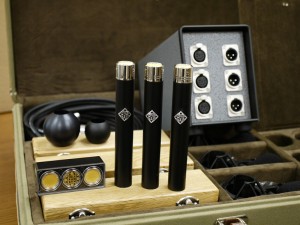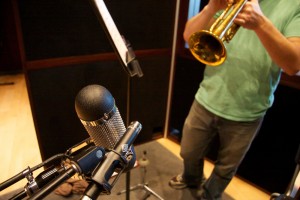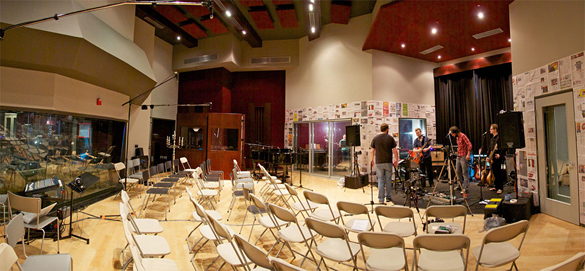Review: Telefunken ELA M 260 Microphone by Zach McNees
Last October, I produced and engineered an album called The Modest Revolution for my friends Enter The Haggis, a Canadian roots-rock band that I’ve worked with for a number of years. We were fortunate to have raised enough money through crowd funding to be able to spend a month tracking at my favorite studio, Saint Claire Recording Company in Lexington, Kentucky.
The last time I was at Saint Claire I had the chance to test out Telefunken’s AR-51 large diaphragm condenser mics. I was so impressed with them that I bought a pair as soon as I finished the project. This time around, Telefunken was kind enough to furnish me with a new set of mics, the Tri-Mono set of ELA M 260 small diaphragm tube condensers. Let’s take a look and listen to how these mics performed!
TECH SPECS: The ELA M 260 condenser mics can be purchased as a single mic, a stereo set or in the Tri-Mono set. Each ELA M 260 mic comes with its own set of three capsules – in cardioid, omnidirectional, and hypercardioid patterns – each of which threads onto the top of the mic. The tube is a Telefunken EF-732.
The single ELA M 260 system retails for $1,495, but for a package deal you can get a matched stereo set ($2,895) or the Tri-Mono set ($4,295), both of which include an upgraded premium power supply and flight case.
IN USE: The ELA M 260s first made an appearance on the ETH album when we were preparing to overdub the acoustic guitars. My assistant Tim Price and I decided to shoot out a bunch of mics in order to find the right acoustic sound.
We put up half a dozen mics or more including a U47 and the studio’s trusty Schoeps small diaphragm condenser (of which I’m a big fan). I began playing and Tim and I started narrowing down the mics we thought worked really well and setting aside the ones that we didn’t like as much. After we narrowed our choices down from the mics that we were already familiar with, we pulled out one of the ELA M 260s from the Tri-Mono set.
I placed the mic about 6-8” from the twelfth fret of the acoustic guitar clustered together with two or three other small diaphragm condensers and began playing as Tim listened in the control room and I listened on headphones. As soon as Tim heard the ELA M 260, he came over the talkback with a “WOW. That mic sounds unbelievable!” He was right. We were both absolutely floored by the clarity, crispness and overall full tone that we were getting from the ELA M 260 with minimal effort.
For tracking, we ended up going with a coincident stereo pair on the acoustic guitar coupled with my AEA R84 ribbon mic right above them which gave me a unique sharpness with the ability to add additional warmth and fullness from the AEA as I felt was necessary.
Over the course of recording sessions for this album, the ELA M 260 won in every mic shootout we put it in – including on fiddle, piano and trumpet. Let’s take a listen to some examples of the mic in action. All of these example clips are only the ELA M 260 mic either in stereo coincident or mono, except the Nashville tuning clip, which is a doubled part.
Check out some ELA M 260-recorded clips from the tracking sessions:
“Blackout” – Acoustic Guitar
“Blackout” – ACOUSTIC
“Can’t Trust The News” – Piano
“Can’t Trust The News” – Piano
“Can’t Trust The News” – Trumpet
“Can’t Trust The News” – Trumpet
“Balto” – Fiddle
“Balto” – Fiddle
“Balto” – Pizzicato
“Balto” – Pizz
“Down The Line” – Acoustic (Nashville tuning)
“Down The Line” – Acoustic (Nashville tuning)
The level of detail is almost three-dimensional with the coincident pair on the acoustic. The top end is detailed and sharp while maintaining an extremely full and well-balanced sound overall.
It’s also worth mentioning that just like with the AR-51 mic, the ELA M 260s have a fantastic XLR-style snapping cable lock that connects the mic to the power supply. This is a great feature that is not only a time saver but also, arguably, will keep the mic in better condition than with a traditional push-in and screw on type connector. The mic clip and case for these mics is also top of the line.
The 260 tri-mono set got quite a workout at Saint Claire on this session. The third weekend of the month, the band and I struck the entire studio setup and transformed the live room of Saint Claire into a live music venue with seating for 50 people. ETH recorded a live in-studio album for their fans over two nights and the ELA M 260s served as the crowd mics for the recording. (pictured)
WRAPPING UP: The Telefunken ELA M 260 mics may be the best sounding small diaphragm condensers I’ve ever used. The only limitation here is the price point. These mics are well built and made from high quality components from the case all the way to the capsule, and the price point is reflected in that quality. When you consider the sheer versatility of these mics, there’s enough value there to more than justify the cost. I’m hoping to pick up a pair of these in the future.
Listen to songs from The Modest Revolution for free at: http://www.enterthehaggis.com. And visit http://www.telefunken-elektroakustik.com for more details on the ELA M 260.
Zach McNees is a Brooklyn-based producer/engineer/mixer and live recordist who’s worked with Björk, Rob Thomas, Julia Nunes, The Gregory Brothers, Pixies, Liars and Alice Cooper. Get in touch with Zach via http://www.zachmcnees.com.
Please note: When you buy products through links on this page, we may earn an affiliate commission.









